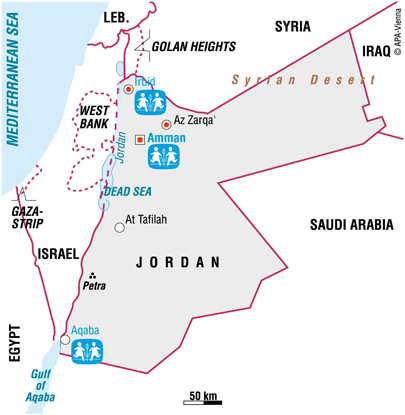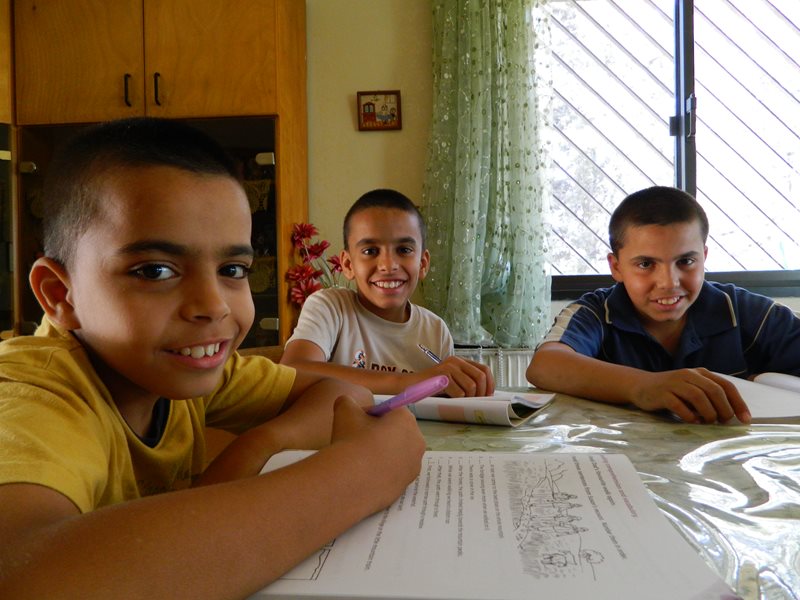
Vi er i Jordan
Most of the population live in urban areas
.jpg?width=800)
Jordan has a population of 8.1 million (July 2014 est.), with the capital city of Amman being home to 1.1 million. Around 80 per cent of the population lives in urban areas. Although over half of the country consists of the Arabian Desert, the western part of Jordan has forests and farmland.
The country is situated in one of the world's most politically volatile regions, making it vulnerable to the areas economic and political developments. In 2011, and as changes were taking place in neighbouring countries, sectors of Jordanian society took to the streets to demand political changes. In addition, the arrival of refugees fleeing from the Syrian conflict has put pressure on public services.
The lives of people have been negatively affected by the recent political changes
Jordan has one of the highest standards of living in the region. A large proportion of the population is highly educated, and most have access to a good health system. This has led to important reductions in infant and maternal mortality rates. The life expectancy rate is one of the highest in the area – 73 years for men and 76 years for women.
The economy has been badly affected by the recent political unrest in the country and region. In the past, tourism has been an important source of employment and income, but recently the number of people visiting the country has plummeted. The official unemployment rate remains relatively high at about 12.5 per cent. Poverty is mostly found in rural areas, where households are bigger and there are fewer opportunities to make a living. As a result many people from the countryside move to the cities, especially to Amman and neighbouring areas, where there is better access to basic services and more employment options. However, this rise in number is putting greater pressure on the urban services.
By the end of 2015, the United Nations expects there to be around 1,000,000 registered refugees in Jordan. Most of the displaced people come from Syria but there are also Iraqis and Palestinians. Around 80 per cent of them are struggling to survive in urban areas; these refugees are amongst the most vulnerable, especially as their access to aid is not guaranteed.
Children in need of protection

Jordan has made some progress in improving the situation of children. There are good schools and health care available to them. Education is highly valued by Jordanian society and government and international aid investment in this sector is high.
However, poverty continues to shape lives of many children. Children from poor families are often forced to work, and this frequently means they drop out of school. In 2014 around 30,000 Jordanian children weren't in school. Many are exposed to harsh and hazardous working conditions in construction, carpentry, and mechanics. The number of child labourers is rising, as is the number of children working and begging on the streets.
Children who are at risk of losing parental care include those where one parent has died, those living in single-parent households and refugee children. The extended family often takes care of children who can no longer live with their parents.
Refugee children are especially vulnerable. Only around 60,000 of them attended school in 2014 and six per cent were sent out to work (UNHCR figures 2014).
SOS Children's Villages in Jordan
SOS Children's Villages in Jordan works to support vulnerable children and families in the following ways:
Family-based care: SOS Children's Villages in Amman, Aqaba and Irbid care for children who cannot live with their parents. The children grow up with their brothers and sisters in SOS families.
Support for young adults: We assist young people until they are able to live independently. They receive the right kind of education and training so that they can make a living in the future.
Education: In Aqaba and Amman, the SOS Kindergarten provides pre-school education to over 160 children. Most of the children come from the local community.
Website of SOS Children's Villages Jordan
(available in English and Arab)